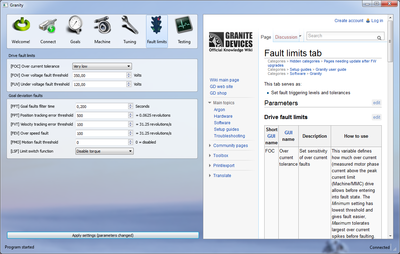Fault limits tab
This tab serves as:
- Set fault triggering levels and tolerances
Parameters[edit | edit source]
Drive fault limits[edit | edit source]
| Short GUI name | GUI name | Description | How to use |
|---|---|---|---|
| FOC | Over current tolerance | Set sensitivity of over current faults | This variable defines how much over current (measured motor phase current above the peak current limit (Machine/MMC) drive allows before entering into fault state. The Minimum setting has lowest threshold and gives fault easier, Maximum tolerates largest over current spikes before faulting.
Set this as low as possible without getting OC faults in normal use to maximally protect your equipment. If larger than Medium setting is needed, see Over current fault troubleshooting for solution to the problem. FOC is firmware specific, it adjust including, but not limited to, the sensitivity of the short circuit protection. It's recommended to set to that which doesn't raise fault flags, and then add 1-2 steps as overhead. |
| FOV | Over voltage fault threshold | Maximum allowed HV DC bus voltage before entering into over voltage fault. Also defines at which voltage drive starts driving braking resistor to reduce bus voltage. | See Configuring drive voltage limits FUV and FOV. |
| FUV | Under voltage fault threshold | Minimum allowed HV DC bus voltage before drive starts motor initialization after power-on. Also if this voltage is exceeded during active operation, drive enters into under voltage fault state. | See Configuring drive voltage limits FUV and FOV. |
Goal deviation faults[edit | edit source]
These settings define how much motor may deviate from the setpoints or allowed operating conditions before entering in fault state.
| Short GUI name | GUI name | Description | How to use |
|---|---|---|---|
| FFT | Goal fault filter time | Set time filter for this fault group. Defines how long drive allows exceeding these conditions before entering into fault state. | Normally values between 0-0.5 seconds are safe. Higher value may pose danger to user or equipment as motor is not being stopped soon after error condition. |
| FPT | Position tracking error threshold | Defines how much position may deviate from the setpoint | The value is set as hardware units. Adjust the value and observe the right side value displaying the hardware value converted to a real world units such as revolutions/s. Make sure Machine tab settings are set-up first to get correct conversion. |
| FVT | Velocity tracking error threshold | Defines how much velocity is allowed to deviate from velocity setpoint | |
| FEV | Over speed fault | Defines the maximum allowed speed (feedback based) which the axis is allowed to operate before entering to the overspeed fault state | |
| FMO | Motion fault threshold | Defines the sensitivity to enter into motion fault. Used for detecting mechanically blocked motion and DC motor runaway (loss of feedback) | If motion fault feature needed, adjust the value experimentally by increasing it until faults don't occur in normal use. A good starting value may be motor continuous current in milliamperes/2. |
| LSF | Limit switch function | Define drive action when position is out of allowed travel range (i.e. limit switch input is open). Device specific notes:
|
Choose preferred action when position of motor is beyond allowed travel (i.e. physical limit switches are open). Choices:
|
| LSP | Limit switch polarity | Set the polarity of connected limit switch state interpretation | Choose which digital logic state represents the overtravel condition. As in typical wiring, switch is connected between GND and limit switch input (which has internal pull-up resistor), then following will apply:
|
| LFO | Perform Limit switch function on | Specifies when Limit switch functionLFS will activate | Typical use cases are:
|
| Read next |
In no event the Product Information or parts hereof shall be regarded as guarantee of conditions or characteristics. The Product Information or any part thereof may also not be regarded as a warranty of any kind. No liability of any kind shall be assumed by Author with respect to Product Information or any use made by you thereof, nor shall Author indemnify you against or be liable for any third party claims with respect to such information or any use thereof.
As content of this Wiki may be edited by user community, Granite Devices Oy or it's affiliates do not take any responsibility of the contents of this Wiki. Use information at your own risk. However, Granite Devices staff attempts to review all changes made to this Wiki and keep information trustworthy.
Without written consent, Granite Devices' Products or Intellectual Property shall not be used in situations or installations where living beings, material property, or immaterial property could be harmed by the operation, features or failures of Product. Products may only be used in a way where hazards like moving parts, electric shock, laser radiation, or fire can't be realized even if the content of this Wiki would suggest otherwise.
